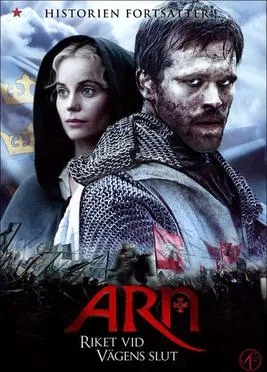Historical accuracy of Arn: The Kingdom at the End of the Road

Historical accuracy of Arn: The Kingdom at the End of the Road

Characters
Arn Magnusson (Joakim Nätterqvist)
The protagonist is entirely fictional, though his story integrates elements of Swedish history and the Crusades.
Cecilia Algotsdotter (Sofia Helin)
A fictional character, possibly inspired by the historical Cecilia Rosa, but her specific story, relationship with Arn, and convent imprisonment are fictionalized.
Birger Brosa (Stellan Skarsgård)
Birger Brosa was a real and influential Jarl during this period. His depiction as a key political figure is accurate, but his familial relationship with Arn is fictional.
King Knut Eriksson (Gustaf Skarsgård)
A real historical King of Sweden. His struggle against the House of Sverker is historical, but his close friendship with the fictional Arn is not.
King Sverker Karlsson (Joel Kinnaman)
A real historical King (Sverker II) who vied for the throne against the House of Erik, accurately depicted as being supported by Denmark.
Erik Knutsson (Bill Skarsgård)
Real historical figure, son of Knut Eriksson, who eventually became King after the Battle of Lena. His presence in the power struggle is accurate.
More characters
Saladin (Milind Soman)
Saladin was the real historical leader of the Ayyubids. His depiction is brief; his recognition and saving of Arn after Hattin is fictional.
Gerard de Ridefort (Nicholas Boulton)
A real Grand Master of the Knights Templar. His depiction as arrogant and responsible for the defeat at Hattin aligns with historical criticism of his leadership.
Ebbe Sunesson (Jakob Cedergren)
Ebbe Sunesen was a real Danish nobleman who led forces supporting Sverker at the Battle of Lena and died there. His death at Arn's hands in a duel is fictional.
Harald Øysteinsson (A. B. Christiansen)
A fictional supporting character created for the story.
Magnus Månsköld (Martin Wallström)
Fictional son of the fictional main characters.
Birger Jarl (foreshadowed)
Birger Jarl was a real, crucial figure in Swedish unification. His portrayal as Arn's grandson connects the fictional narrative to established history but is not factual.
Story
Arn's return to Sweden after 20 years
The premise is based on the fictional protagonist Arn Magnusson.
Battle of Hattin (1187) depiction
The battle occurred, and the Crusaders suffered a major defeat often blamed on Gerard de Ridefort. Arn's presence, survival, and interaction with Saladin are fictional elements.
Establishment of Forsvik Estate
Forsvik is a real place, but its depiction as Arn's multicultural estate built with knowledge from the Holy Land is fictional.
Conflict between House of Erik & House of Sverker
The film accurately portrays the real dynastic struggle for the Swedish throne between these two powerful families during the 12th and early 13th centuries.
Danish support for Sverker II
Denmark did provide military support to Sverker Karlsson the Younger in his attempts to regain the Swedish throne.
Battle of Lena (1208)
This historical battle resulted in a victory for Erik Knutsson over Sverker II and his Danish allies. The film's depiction of Arn leading forces and employing specific tactics is fictional.
Use of archers/foreign tactics at Lena
While archers were used, the film's emphasis on tactics learned in the Holy Land influencing the battle is part of Arn's fictional narrative. Specifics of the real battle are sparse.
Arn kills Ebbe Sunesson in duel at Lena
Ebbe Sunesson died at Lena, but his death in a duel with the fictional Arn is an invention.
Battle of Gestilren (1210)
This historical battle saw the final defeat and death of Sverker II, securing the throne for Erik Knutsson. Arn's participation and death in this battle are fictional.
Arn's actions paving way for Swedish unification
The idea that the fictional Arn's victories directly led to unification via his fictional grandson Birger Jarl merges fiction with the real historical process.
Cecilia's 20-year confinement in convent
Based on the fictional premise of her relationship with Arn and punishment.
Setting
Medieval Sweden (Götaland c. 1200)
Accurately portrays Sweden as a not-yet-unified kingdom dominated by powerful families (Folkung) vying for power, with significant Church influence.
Holy Land depiction (Gaza, Hattin)
Provides a visual backdrop for Arn's Templar past, though focus is limited. Locations like Gaza and the Battle of Hattin site are represented.
Clothing and Costumes
Aims for a medieval aesthetic suitable for the period (late 12th/early 13th C.), though specific details might prioritize visual appeal over strict historical accuracy.
Armor and Weaponry
Standard medieval arms like swords, spears, axes, and mail are shown. Some specific armor elements (like certain gambesons) have been noted as potentially anachronistic.
Castles and Buildings
Depicts fortifications and settlements appropriate for the era, though perhaps generic rather than specific recreations.
Depiction of Battle Tactics
Battle scenes (Lena, Gestilren) show large-scale clashes. Specific tactics, especially those attributed to Arn, blend historical possibilities with fictional narrative.
Influence of the Church and Templars
Shows the significant societal power of the Church in Sweden (forcing Cecilia into a convent) and the role of military orders like the Templars in the Crusades.
Multiculturalism brought by Arn to Sweden
The idea of Arn establishing a center with craftsmen and knowledge from the Middle East (Forsvik) is a fictional element reflecting modern ideals more than history.
